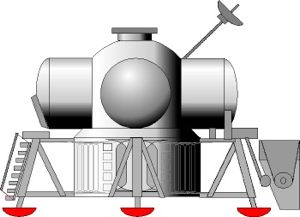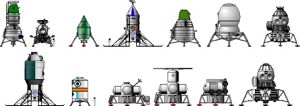
Home - Search - Browse - Alphabetic Index: 0- 1- 2- 3- 4- 5- 6- 7- 8- 9
A- B- C- D- E- F- G- H- I- J- K- L- M- N- O- P- Q- R- S- T- U- V- W- X- Y- Z
LZM
 LZM Credit: © Mark Wade |
AKA: Laboroatorno-zavodskoy modul';Vulkan-launched version. Status: Study 1973. Payload: 6,070 kg (13,380 lb). Gross mass: 15,500 kg (34,100 lb). Height: 4.50 m (14.70 ft).
Single story, four-lobed facility dedicated to lunar surface biological and physics research and production of oxygen from lunar soil for long-duration stay on the lunar surface.
Clockwise, from the entry ladder: airlock; biological laboratory; oxygen production factory with scoop for digging lunar soil; physics-chemistry laboratory. An attic above the center contained hydroponic facilities for growing fresh food. Equipment weights: Biological lab, 950 kg; Physics-chemistry lab, 1,920 kg; oxygen factory, 3,200 kg. The LZM would be normally tended by one operator, who would live in the LZhM.
Crew Size: 1. Habitable Volume: 100.00 m3. Electric System: 8.00 average kW.
Family: Lunar Habitats, Moon. Country: Russia. Spacecraft: LEK Lunar Expeditionary Complex. Launch Vehicles: Energia, Vulkan. Agency: Korolev bureau. Bibliography: 367, 89.
1975 January 1 - .
- Vulkan Lunar Base - .
Nation: Russia.
Related Persons: Barmin,
Bushuyev,
Glushko,
Mishin.
Program: Lunar L3.
Spacecraft: LEK,
Lunokhod LEK,
LZhM,
LZM.
Mishin and Barmin, using budget provided by the Ministry of Defence, had designed a lunar base for launch by the N1 in 1969-1974. After the cancellation of the N1, Glushko pleaded with the Military-Industrial Commission for the work to be taken from Barmin and be given to NPO Energia. Glushko's alternative, Vulkan-launched base was elaborated within his bureau. Bushuyev developed spacecraft for the base. Prudnikova developed a modular lunar city, with living modules, factory modules, a nuclear reactor power module, and a lunar crawler with a 200 km radius of action. The project work was only finally cancelled after the Apollo-Soyuz flights.
1977 December 1 - . Launch Vehicle: N1.
- Glushko uninterested in further lunar base work - .
Nation: Russia.
Related Persons: Bushuyev.
Spacecraft: Buran,
LEK,
Lunokhod LEK,
LZhM,
LZM.
Bushuyev tells Chertok that the lunar base work did not interest Glushko. The VPK Military-Industrial Commission was only interested in duplicating the American shuttle, not in any other ventures in space. With the N1-Sr booster, Russia could have had a six man lunar base established with 8 to 10 launches in the late 1970's. Bushuyev died on 26 October 1978, having seen his dream completely tossed away.
1978 January 1 - .
- Vulkan Lunar Base rejected - .
Nation: Russia.
Related Persons: Glushko,
Keldysh.
Spacecraft: LEK,
Lunokhod LEK,
LZhM,
LZM.
An expert commission led by Keldysh examines the plan for a lunar base launched by the Vulkan booster. The plan is completely rejected. NPO Energia was told to quit dreaming and devote itself only to projects with national economic importance, like Buran. This put a definitive end to Glushko's lunar base projects studied in 1976-1978. But he just waited and started design work again on a lunar base using the Energia launch vehicle after the first Buran launch in 1988.
Back to top of page
Home - Search - Browse - Alphabetic Index: 0- 1- 2- 3- 4- 5- 6- 7- 8- 9
A- B- C- D- E- F- G- H- I- J- K- L- M- N- O- P- Q- R- S- T- U- V- W- X- Y- Z
© 1997-2019 Mark Wade - Contact
© / Conditions for Use
